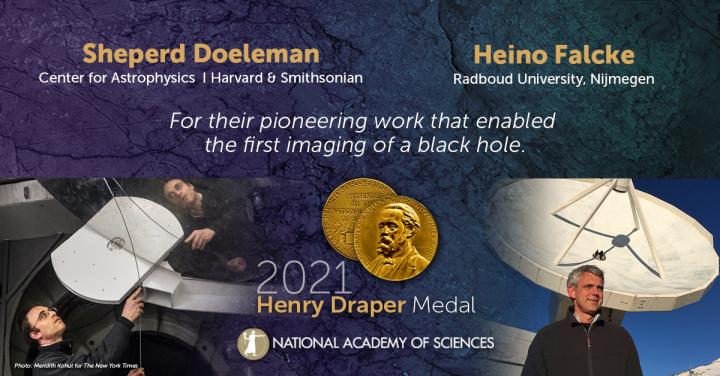American National Academy of Sciences honours Heino Falcke and Sheperd Doeleman with the Henry Draper Medal

Credit: National Academy of Sciences
Astronomers Heino Falcke of Radboud University and Sheperd Doeleman of the Harvard-Smithsonian Center for Astrophysics will jointly receive the Henry Draper Medal for their pioneering work, which led to the first image of a black hole. The medal is awarded every four years by the American National Academy of Sciences (NAS) and is presented with a $25,000 prize. It is the first time in 65 years that a Dutch astronomer will receive this special award.
The Henry Draper Medal honours a recent, original investigation in astronomical physics. It is the oldest NAS prize and was first awarded in 1886. Since that time, 54 scientists have received the medal, including eight Nobel Prize winners.
This is the third time that a Dutch astronomer will receive the award. In 1955, Dutch astronomer Hendrik van der Hulst was honoured for the discovery of the 21 cm radiation of cosmic hydrogen. Pieter Zeeman was honoured in 1921 for the discovery of the Zeeman Effect.
Falcke and Doeleman are both founders of the Event Horizon Telescope (EHT) consortium that published the first photograph of a black hole in 2019. The NAS writes in their award statement: “Both scientists are pivotal in realizing the image of the supermassive black hole in the M87 galaxy, supporting Einstein’s Theory of Relativity. Their work has attracted both scientific and public interest.”
In 2000, Falcke coined the term “shadow of the black hole” to describe the effect of the bending of light by the black hole, and predicted that it must be possible to image a black hole with the use of radio telescopes. He envisioned a network of high-frequency radio telescopes connected to each other across the world to do this.
“Naturally, I am very thankful and proud to receive such a prestigious award. It is a very unique and rare prize that feels to me a bit like an Olympic medal. A lot of pioneering research has been released since the publication of the image which means that we now have an even better understanding of gravity around a supermassive black hole,” says Heino Falcke. “In the end, we have only been able to get this result through the collaborative effort of the whole team.”
The EHT is an example of an achievement by a global team that required a close collaboration between researchers from all over the world. 13 partner institutes worked together to establish the EHT, including Radboud University. From the Netherlands astronomers from the University of Amsterdam, Leiden University, and JIVE are also involved in the project, as well as the NOVA submm group of the University of Groningen. This was initially made possible via the BlackHoleCam project which is funded by the European Research Council (ERC).
Other Awards
The EHT has been awarded many prizes and honourable mentions. It previously received the Breakthrough Prize, the “Oscar of the Sciences”, and it was mentioned in Time magazine’s year in review. The team was awarded the 2020 Bruno Rossi Prize by the American Astronomical Society. It recently also received the British Royal Astronomical Society Group Achievement Award. For the EHT, Heino Falcke and Shep Doeleman will jointly receive the Einstein Medal from the Einstein-Gesellschaft in Bern when the coronavirus pandemic is over.
The 2021 Henry Draper Medal ceremony will be held on 25 April. This can be watched on a live stream.
###
Media Contact
Science Communication Radboud University
[email protected]
Original Source
https:/




